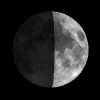Courtesy of EarthSky
A Clear Voice for Science
Visit EarthSky at
www.EarthSky.org [1]
 [2]
[2] [3]Practiced stargazers sometimes use three stars of the constellation Aries the Ram to find an elusive galaxy – M74 – also known as the Phantom galaxy.
[3]Practiced stargazers sometimes use three stars of the constellation Aries the Ram to find an elusive galaxy – M74 – also known as the Phantom galaxy.
As seen from the world this evening, the first quarter moon [4] shines in front of the constellation Pisces the Fishes, not far at the Aries/Pisces border. The three stars mentioned above are to the moon’s upper left tonight. They depict the head of Aries the Ram. In their order of brightness, these stars are Hamal, Sheratan and Mesarthim. The star Eta Piscium in Pisces may be hard to see tonight because of the moonlit glare, but this star is fairly easy to pick out on a dark, moonless night.
Practiced stargazers often starhop to M74 (the Phantom galaxy), using the three Aries’ stars and Eta Piscium. You might be able to spot the star Eta Piscium with binoculars tonight. Will you see M74? No way! Of the more than 100 Messier deep-sky objects cataloged by the famous comet hunter, Charles Messier, this galaxy is one of the hardest to see in a telescope.
 [5]Yet M74 – the Phantom galaxy – is a fascinating object. It has the lowest surface brightness of all the Messier objects because it is a face-on spiral galaxy some 35 million light-years [6] away. The image at right was taken through the Hubble Space Telescope. Our eyes cannot see the galaxy like this. In amateur telescopes, M74 is barely visible. It is best viewed under low magnification. Telescope practioners use averted vision when seeking this galaxy. In other words, like many sorts of ghosts, it disappears when you look at it directly. (Image: NASA, ESA and Gemini Observatory)
[5]Yet M74 – the Phantom galaxy – is a fascinating object. It has the lowest surface brightness of all the Messier objects because it is a face-on spiral galaxy some 35 million light-years [6] away. The image at right was taken through the Hubble Space Telescope. Our eyes cannot see the galaxy like this. In amateur telescopes, M74 is barely visible. It is best viewed under low magnification. Telescope practioners use averted vision when seeking this galaxy. In other words, like many sorts of ghosts, it disappears when you look at it directly. (Image: NASA, ESA and Gemini Observatory)
Therefore, you don’t really need a super high-powered telescope to see the Phantom galaxy, but you do need a perfectly dark and transparent sky. Every March, when it is technically possible (though difficult) to spot all the Messier objects in one night, M74 [7] is one that is commonly missed.
Written by Bruce McClure [8]
Astronomy Picture of the Day from NASA/JPL [9]
EarthSky: Space [10]
CHANDRA Photo Album [11]
U.S. Naval Observator Astronomical Information cente [12]r
Universe Today [13]
StarDate Online [14]
Sky and Telescope [15]
National Geographic [16]
Space Com [17]
Simostronomy Blog [18]
Amazing Space [19]
The York County Astronomical Society [20]
Scope City [21]